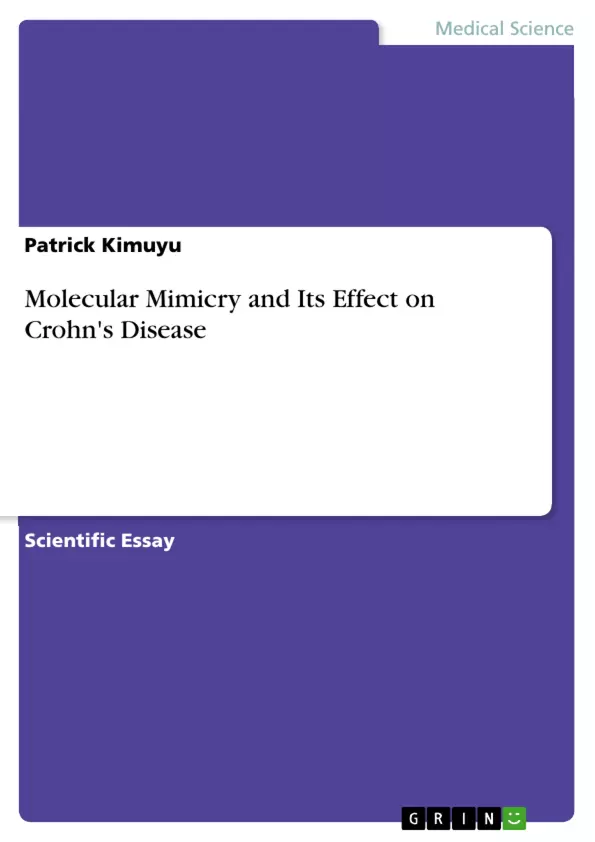Molecular mimicry is a well-documented biological phenomenon and its link to autoimmune diseases has led to extensive research. From an epidemiological perspective, autoimmune diseases have been found to exhibit multifactorial origins. In most cases, genetic predisposition, as well as environmental factors leads to tissue injury owing to the activity of autoreactive antibodies or T cells. One of the most striking characteristics of autoimmune diseases is that the initial biological processes that lead to the loss of tolerance do not match with clinical manifestations. These manifestations occur long after the mechanisms associated with loss of tolerance. It is believed that loss of tolerance is responsible for the severity of chronic autoimmune diseases. Currently, there are several pathological processes involved in the breakdown of immunologic tolerance. These mechanisms include activation of polyclonal lymphocytes, abnormalities in self antigens presentation, molecular mimicry, and presence of autoreative lymphocytes (Bellone, 2005). In Crohn’s disease, as well as other autoimmune diseases such as ulcerative colitis, multiple sclerosis, and type 1 diabetes mellitus, molecular mimicry is hypothesized to be one of the key mechanisms leading to the breakdown of immunological self tolerance. Therefore, this paper will provide a comprehensive overview on molecular mimicry and its effects on autoimmune diseases with a principal focus on Crohn’s disease.
Inhaltsverzeichnis (Table of Contents)
- Molecular Mimicry and Its Effect on Crohn's Disease
- Molecular Mimicry
- Central and Peripheral Tolerance
- Amino Acid Sequence Homology
- Epitope Spreading
- Dual TCRs Expression
- Crohn's Disease
- Klebsiella Pneumonia
- Mycobacterium Avium Subsp. Paratuberculosis (MAP)
- Key Genes Expressed in Crohn's Disease
- The Role of Natural Killer T Cells (NKT)
Zielsetzung und Themenschwerpunkte (Objectives and Key Themes)
This paper aims to provide a comprehensive overview of molecular mimicry and its effects on autoimmune diseases, with a primary focus on Crohn's disease. It delves into the mechanisms behind molecular mimicry and its role in the breakdown of immunological self-tolerance.
- Molecular mimicry as a key mechanism leading to the breakdown of immunological self-tolerance in autoimmune diseases.
- The role of infections and the theory of molecular mimicry in the development of autoimmunity.
- The influence of amino acid sequence homology, epitope spreading, and dual TCRs expression in molecular mimicry.
- The specific involvement of molecular mimicry in the pathogenesis of Crohn's disease and the role of infectious agents like Klebsiella pneumoniae and Mycobacterium avium subsp. Paratuberculosis (MAP).
- The impact of molecular mimicry on the expression of key genes in Crohn's disease and the involvement of natural killer T cells (NKT) in the disease.
Zusammenfassung der Kapitel (Chapter Summaries)
- Molecular Mimicry: This chapter introduces the phenomenon of molecular mimicry, its clinical significance, and its role in autoimmune diseases. It explains how molecular mimicry occurs through T cell selection, co-stimulation, and antigen recognition.
- Central and Peripheral Tolerance: This chapter explores the two main mechanisms that protect against autoimmunity: central and peripheral tolerance. It describes how these mechanisms function and how their breakdown can lead to the development of autoimmune diseases.
- Amino Acid Sequence Homology: This chapter examines the concept of amino acid sequence homology as a basis for molecular mimicry. It discusses the prevalence of amino acid sequence similarities between humans and other organisms and explores the complex processes involved in molecular mimicry beyond simple sequence homology.
- Epitope Spreading and Dual TCRs Expression: This chapter delves into two key processes that contribute to molecular mimicry: epitope spreading and dual TCRs expression. It explains how epitope spreading can lead to the activation of cryptic epitopes and how dual TCRs can rescue autoreactive T cells.
- Crohn's Disease: This chapter focuses on the specific link between molecular mimicry and Crohn's disease. It highlights the roles of two main infectious agents, Klebsiella pneumoniae and Mycobacterium avium subsp. Paratuberculosis (MAP), in the pathogenesis of the disease.
- Key Genes Expressed in Crohn's Disease: This chapter examines the key genes expressed in Crohn's disease and how they might be affected by molecular mimicry. It explores the roles of CARD15, DLG5, SLC22A4/5, MDR1, and PPARG in the disease.
- The Role of Natural Killer T Cells (NKT): This chapter discusses the involvement of natural killer T cells (NKT), specifically invariant natural killer T cells (iNKT), in the pathogenesis of Crohn's disease. It highlights their role in recognizing glycolipidic structures and how they may contribute to molecular mimicry in people with Crohn's disease.
Schlüsselwörter (Keywords)
Molecular mimicry, autoimmune disease, Crohn's disease, immunological self-tolerance, infections, amino acid sequence homology, epitope spreading, dual TCRs expression, Klebsiella pneumoniae, Mycobacterium avium subsp. Paratuberculosis (MAP), CARD15, natural killer T cells (NKT), iNKT cells.
- Quote paper
- Patrick Kimuyu (Author), 2018, Molecular Mimicry and Its Effect on Crohn's Disease, Munich, GRIN Verlag, https://www.grin.com/document/388522



